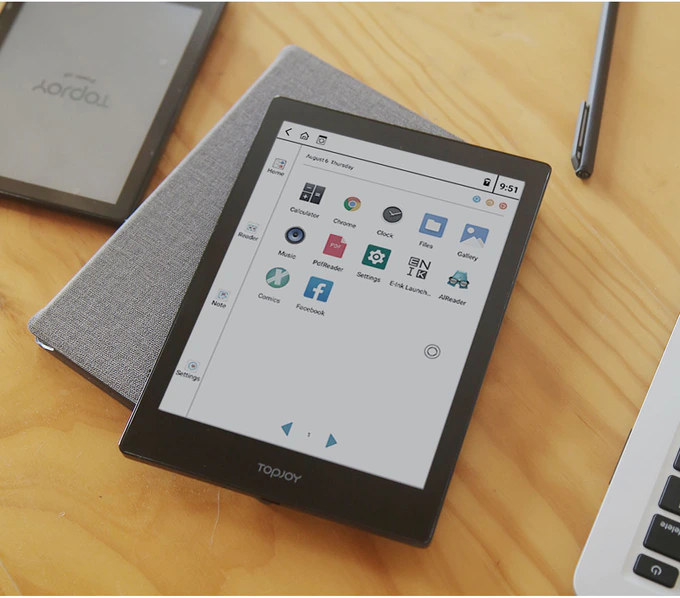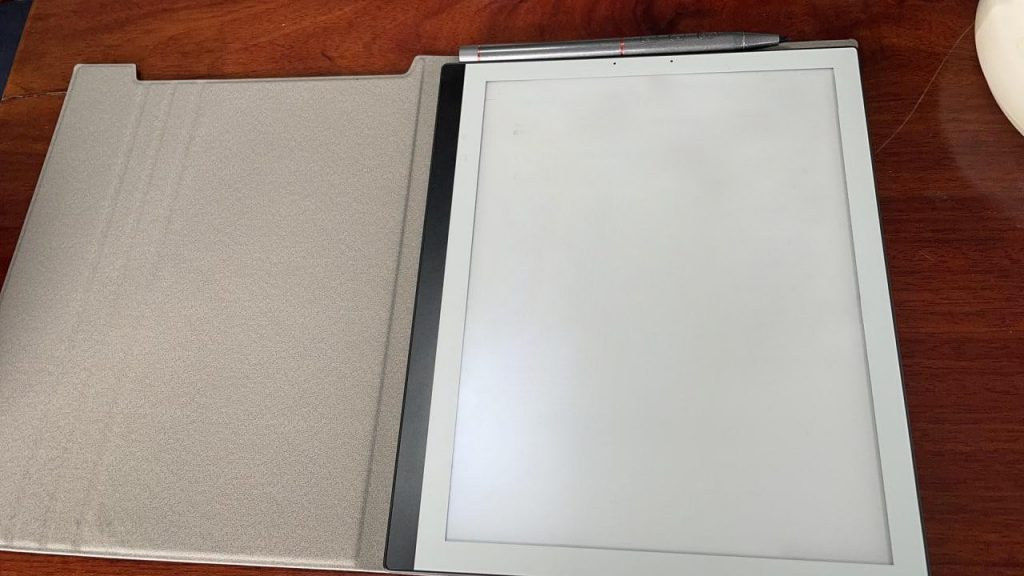FOSDEM – which stands for Free and Open Source Software Developers’ European Meeting – is a free-to-participate event where thousands of developers meet in Brussels on the first week-end of February to discuss open-source software & hardware projects. FOSDEM 2024 will take place on February 3-4 with 880 speakers, 818 events, and 66 tracks. Although I won’t attend, I’ve created a virtual schedule like every year with sessions most relevant to the topics covered on CNX Software from the “Embedded, Mobile and Automotive” and “Open Hardware and CAD/CAM” devrooms, but also other devrooms including “FOSS Mobile Devices”, “ Energy: Reimagining this Ecosystem through Open Source”, “RISC-V”, and others. FOSDEM Day 1 – Saturday, February 3, 2024 10:30 – 10:55 – Screen Sharing on Raspberry Pi 5 Using VNC in Weston and Wayland with the Yocto Project and OpenEmbedded by Leon Anavi In 2023, embedded Linux developers received eagerly awaited news: […]
PineNote Developer Edition mainline Linux e-Reader is now available for $399
Pine64 community has been on a tear in 2022, with the launch of the PineNote Developer Edition Linux e-reader following the availability of the PinePhone keyboard case and PinePhone Pro Explorer Edition Linux smartphone in the last 2-3 weeks. So far a limited number of PineNote prototypes had been sent to developers, but it’s now possible to order the PineNote Developer Edition for $399 directly on the Pine64 store. As its name implies, the e-Reader is not ready for end-users, but recent progress with mainline Linux makes it suitable for developers and enthusiasts who want to play around with the device knowing much more work is needed to make it a usable device. The specifications remain the same as in the initial PineNote announcement: SoC – Rockchip RK3566 quad-core A55 processor @ 1.8 GHz with Arm Mali-G52 EE GPU, 0.8 TOPS NPU (AI accelerator) System Memory – 4GB of LPDDR4 […]
TopJoy ButterFly is a Full-Color DES Screen e-Reader with Android 11 (Crowdfunding)
TopJoy ButterFly is a full-color DES screen e-Reader running Android 11 on a quad-core Cortex-A55 processor that appears to be the same Rockchip RK3566 processor used in the upcoming PineNote e-reader. Two models of the e-Reader are offers with E601 fitted with a 6-inch display and E701 with a larger 7.8-inch display both offering 300 PPI for black & white content and 150 PPI for color, and equipped with 2GB RAM & 32GB storage by default, an option for 4GB RAM and 64GB storage for the larger display. TopJoy Butterfly specifications: SoC – Rockchip RK3566 quad-core A55 processor up to 1.8 GHz with Mali-G52 EE GPU, 0.8 TOPS AI accelerator System Memory – 2GB RAM (option for 4GB for E701) Storage – 32 GB eMMC flash (option for 64GB for E701) Display E601 – 6-inch DES color e-Paper display with 1072 x 1448 resolution; 150 PPI for color, 300 PPI […]
PineNote is a community supported 10.3-inch e-Reader based on Rockchip RK3566 SoC
We’ve covered several e-readers in the past, but the PineNote 10.3-inch e-reader will be a bit different, as the hardware & software will be entirely developed by the community like other Pine64 platforms such as Pinebook Pro, PineCone, Rock64 single board computer, etc… Based on the Rockchip RK3566 quad-core Cortex-A55 processor, PineNote will be one of the fastest e-readers on the market, and leverage the code already written for Quartz64 single board computer, including mainline Linux support. PineNote (preliminary) specifications: SoC – Rockchip RK3566 quad-core A55 processor with Mali-G52 EE GPU, 0.8 TOPS NPU (AI accelerator) System Memory – 4GB of LPDDR4 RAM Storage – 128GB eMMC flash Display – 10.3-inch panel with 1404×1872 resolution (227 DPI), 16 levels of grayscale, front light with cool (white) to warm (amber) light adjustment, capacitive glass layer for finger touch-based input, and a Wacom electromagnetic resonance layer (EMR) for EMR pen input. There’s […]
DIY Linux e-Reader – postmarketOS now runs on Kobo Clara HD
postmarketOS is a Linux operating system designed for phones, notably the PinePhone, and based on Alpine Linux. But now it’s possible to install the Linux distribution on Kobo Clara HD e-Reader (about $115), so you could have your own Linux e-Reader in a way that’s more versatile than with commercial solutions. The image can either be based on the vendor kernel or the mainline kernel. The latter works without modification to the X server, and the framebuffer can be used directly with either kernel, but most free e-reader programs such as koreader, plato, and inkbox are developed for the slightly different framebuffer API used in the vendor kernel. The demo below relies on Sxmo UI optimized for the PinePhone, and Martijn Braam notes that it can be pretty hard notably because only one hardware button is present on the Kobo device while the interface requires 3 hardware input buttons. But […]
KloudNote 10.3-inch E-reader supports WiFi, Bluetooth and cellular connectivity
Geniatech used to be better known for their Amlogic TV boxes, before expanding their business to development boards and systems-on-modules. But the company has now introduced KloudNote, a 10.3-inch E-reader running Android 8.1 on a quad-core Cortex-A35 processor. The device is equipped with 2GB of RAM and a 16GB eMMC flash, supports WiFi 5 and Bluetooth, as well as optional 2G/3G/4G LTE cellular connectivity, and comes with a USB-C port and a headphone jack. KloudNote (sometimes written Kloud Note) specifications: SoC – Unnamed quad-core Cortex-A35 processor @ 1.2 GHz System Memory – 2GB RAM Storage – 16GB or 32GB eMMC flash Display – 10.3-inch E-Ink flexible screen with cover-lens, 1872×1404 resolution, capacitive touch and electromagnetic touch with support for a stylus with 4096-level of pressure sensitivity Connectivity 802.11 a/b/g/n/ac WiFi 5, Bluetooth 4.2 Optional 2G/3G/4G Audio – Earphone jack, built-in speaker & microphone USB – 1x USB-C port for charging Documents […]
7.8-inch PocketBook InkPad Color eReader launched for $329
Color eReaders and color e-Ink smartphones have started to show up last year with products such as Onyx Boox Poke2 Color, PocketBook Color, or Hisense A7 CC with displays ranging from 6-inch to 6.7-inch in size. If you like the idea of having a color eReader, but would prefer a (slightly) large display, PocketBook InkPad Color may be an interesting option with the eReader featuring a 7.8-inch Kaleido e-Ink display with 4096 colors. PocketBook InkPad Color specifications: Processor – Unnamed dual-core processor @ 1 GHz (probably Allwinner B288 dual-core Arm Cortex-A7 processor) System Memory – 1GB RAM Storage – 16GB eMMC flash, and microSD card reader up to 32GB Display – 7.8 inch E-Ink Kaleido display with 1872 x 1404 (16 shades of grey – 300 ppi) or 624 x 468 (color – 100 ppi) resolution, capacitive touch, and front-light Connectivity – WiFi 4 and Bluetooth (e.g. for audio) USB […]
PocketBook Color is a More Affordable 6-inch Color eReader
As we noted earlier this month the first color eReaders are coming to market, but the $299 price tag of Onyx Boox Poke2 Color eReader may have some people thinking twice before purchasing this type of device. The good news is there’s now a cheap alternative with PocketBook Color available on Newegg for $229 with the exact same E-ink Kaleido 4096-color display. PocketBook Color (PB633-N-WW) hardware specifications: SoC – Allwinner B288 dual-core Arm Cortex-A7 processor @ 1 GHz System Memory – 1GB RAM Storage – 16GB eMMC flash, MicroSD card slot up to 32GB Display – 6-inch 4096-color 16-greyscale E-Ink Kaleido touchscreen display with 1448 x 1072 (greyscale) resolution; 300 DPI for greyscale, 100 DPI for color; built-in frontlight for comfortable reading in darker places Audio – Via headphone connected to micro USB adapter or Bluetooth only Wireless Connectivity – Wi-Fi and Bluetooth USB – 1x Micro USB port Sensors […]










